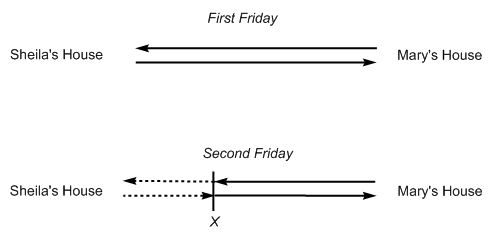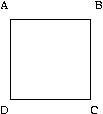Schools Mathematics Grand Challenge
Week seven's Puzzles
Problem 19:
The nineteenth problem was:
A large convoy of mini-buses travelled from Limerick to Croke Park for
the rugby match last weekend. When starting out from Limerick, all of the
coaches carried exactly the same number of passengers. However, on the
way to Dublin, 10 coaches broke down, and in order to accomodate all of
the passengers from these 10 coaches, each of the remaining coaches took
exactly one extra passenger. After the match, before returning back to
Limerick, the organisers found that a further 15 coaches had broken down.
However, everyone was once again accommodated, and, on the way back to
Limerick, each mini-bus had exactly three more passengers than it had
when leaving Limerick in the morning.
How many people travelled to the match on the minibuses?
The solution was:
Let X denote the number of coaches that left Limerick in the morning
and let Y denote the number of people on each mini-bus. Then the total
number of people who travelled to the match is XY (X multiplied by Y).
We also know that
(X - 10)(Y + 1) = XY
and
(X - 25)(Y + 3) = XY.
The first equation gives us
X = 10Y + 10
and the second equation gives
3X= 25y + 75.
Subsitituting for X we get that
30Y + 30 = 25Y + 75
so Y = 9, and X = 100.
Thus the total number that travelled to the match is 900.
Problem 20:
The twentieth problem was:
One Friday evening, Mary walked from her house to Sheila's house at a
constant speed, arrived at Sheila's house at 8 pm, and then they both
immediately walked the same route back to Mary's house. Next Friday,
Sheila was ready earlier than usual and started to walk along the route
towards Mary's house at some time before 8 pm. She met Mary coming
towards her along the route, at which point, Mary turned around and
walked back to her house with Sheila. On this occasion they reached
Mary's house exactly 16 minutes earlier than on the previous Friday.
If the two friends walked at the same constant speed on both Fridays,
and Mary left her house at the same time both days, how many minutes
before 8 do they met the second day?
The solution was:
The two journeys that Mary makes on the consecutive Fridays are
illustrated in the diagram below. She meets Sheila at the point X on
the second Friday.

The difference on the second Friday is that she does not have to walk
the part of the route indicated by the dashed arrows. As she leaves her
house at the same time both evenings and arrives home 16 minutes earlier
the second evening, this part of the journey must have taken exactly 16
minutes, 8 minutes in each direction.
As she walked at the same speed both days, on the second Friday she
must have met Sheila exactly eight minutes before 8. Hence the answer
is 8 minutes.
Problem 21:
The twenty first problem was:
One Sunday afternoon, John walked around the square path shown below.

When asked how long it took him to complete the circuit, he could not
remember. However, he did record the following odd information about
the timing of different parts of the walk.
- He walked at a constant speed along each side of the square;
- His speed was different along each side of the square (so his constant
speed from A to B was different to the constant speed from B to C and
so on);
- The first two thirds of the walk (in distance) took him exactly 10
minutes longer than the final two thirds of the walk;
- The side from C to D took longer than the side from A to B, and the
time taken to go from B to C was longer than the time taken from D to
A by exactly the same amount.
How much longer did the side from A to B take than the side from D to A?
The solution was:
Let W, X, Y, Z represent the times taken to walk the legs AB, BC, CD,
DA respectively. Then John's third piece of information implies that
W + X + (2/3)Y = (2/3) X + Y + Z + 10.
and John's fourth piece of information tells us that
Y - W = X - Z.
We are looking for W - Z. The first equation gives us
W - Z = (1/3)(Y - X) + 10
while the second equation gives
Y - X = W - Z.
Thus,
W - Z = (1/3)(W - Z) + 10
and
(2/3)(W - Z) = 10
so W - Z = 15, and the answer is 15 minutes.
|